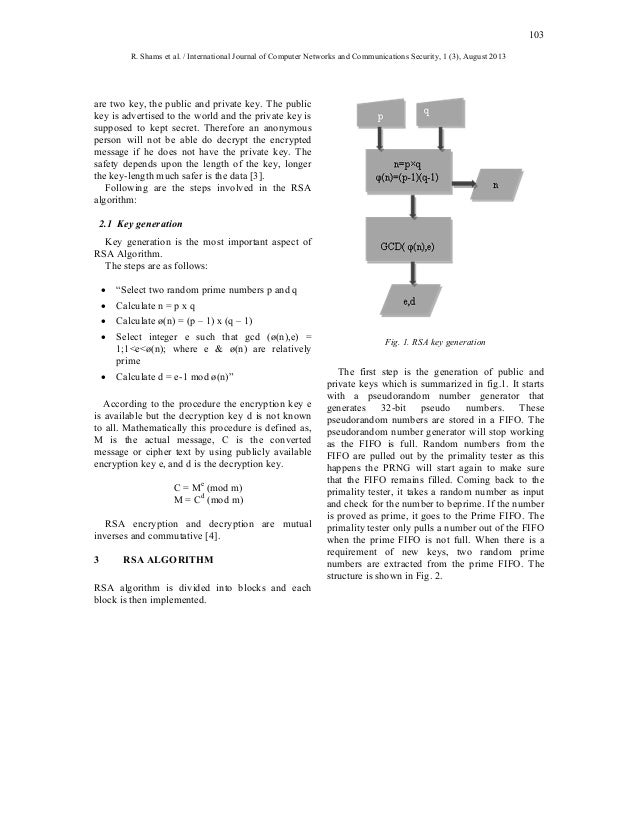Advanced Encryption Standard(AES) is a symmetric encryption algorithm. AES is the industry standard as of now as it allows 128 bit, 192 bit and 256 bit encryption.Symmetric encryption is very fast as compared to asymmetric encryption and are used in systems such as database system. Following is an online tool to generate AES encrypted password and decrypt AES encrypted password. It provides two mode of encryption and decryption ECB and CBC mode. For more info on AES encryption visit this explanation on AES Encryption.
Encrypted message can be decrypted only by private key known only by Receiver. Receiver use the private key to decrypt message to get Plain Text. Step 1 Set p and q. Choose p and q as prime numbers. Step 2 Choose public key e (Encryption Key) Choose e from below values. RSA Calculator JL Popyack October 1997 This guide is intended to help with understanding the workings of the RSA Public Key EncryptionDecryption scheme. Encryption-decryption operations are much faster.

Also, you can find the sample usage screenshot below:
Rsa Decrypt Calculator
If You Appreciate What We Do Here On Devglan, You Can Consider:
- Like us at: or follow us at
- Share this article on social media or with your teammates.
- We are thankful for your never ending support.
Usage Guide
Any plain-text input or output that you enter or we generate is not stored on this site, this tool is provided via an HTTPS URL to ensure that text cannot be stolen.
For encryption, you can either enter the plain text, password, an image file or a .txt file that you want to encrypt. Now choose the block cipher mode of encryption. ECB(Electronic Code Book) is the simplest encryption mode and does not require IV for encryption. The input plain text will be divided into blocks and each block will be encrypted with the key provided and hence identical plain text blocks are encrypted into identical cipher text blocks. CBC mode is highly recommended and it requires IV to make each message unique. If no IV is entered then default will be used here for CBC mode and that defaults to a zero based byte[16].
The AES algorithm has a 128-bit block size, regardless of whether you key length is 256, 192 or 128 bits. When a symmetric cipher mode requires an IV, the length of the IV must be equal to the block size of the cipher. Hence, you must always use an IV of 128 bits (16 bytes) with AES.
AES provides 128 bit, 192 bit and 256 bit of secret key size for encryption. Things to remember here is if you are selecting 128 bits for encryption, then the secret key must be of 16 bits long and 24 and 32 bits for 192 and 256 bits of key size. Now you can enter the secret key accordingly. By default, the encrypted text will be base64 encoded but you have options to select the output format as HEX too.
Similarly, for image and .txt file the encrypted form will be Base64 encoded.
Below is a screenshot that shows a sample usage of this online AES encryption tool.
AES decryption has also the same process. By default it assumes the entered text be in Base64. The input can be Base64 encoded or Hex encoded image and .txt file too. And the final decrypted output will be Base64 string. If the intended output is a plain-text then, it can be decoded to plain-text in-place.
But if the intended output is an image or .txt file then you can use this tool to convert the base64 encoded output to an image.
Please enable JavaScript to view the comments powered by Disqus.Other Free Tools
Encryption uses a classic alphabet, and two integers, called coefficients or keys A and B, these are the parameters of the affine function Ax+B.
Example: Encrypt DCODE with the keys A=5, B=3 and the English/latin alphabet ABCDEFGHIJKLMNOPQRSTUVWXYZ.
For each letter of the alphabet is associated to the value of its position in the alphabet (starting at 0).
Rsa Decryption Key Calculator Free
Example: By default, A=0, B=1,..., Z=25, but it is possible (but not recommended) to use A=1, ..., Y=25, Z=0 using the alphabet ZABCDEFGHIJKLMNOPQRSTUVWXY.
For each letter of value $ x $ of the plain text, is associated a value $ y $, resulting of the affine function $ y = A times x + B mod 26 $ (with $ 26 $ the alphabet size). For each value $ y $, corresponds a letter with the same position in the alphabet, it is the ciphered letter. The Affine ciphertext is the replacement of all the letters by the new ones.
Example:DCODE is crypted SNVSX
| Plain letter | $ x $ | $ y $ | Cipher letter |
| D | 3 | $ 5 times 3 + 3 = 18 $ | S |
| O | 14 | $ 5 times 14 + 3 = 73 = 21 mod 26 $ | V |



